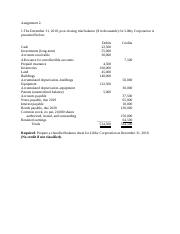Post-Closing Trial Balance Example, Purpose Format, Preparation, Errors
Content

In steps 1 and 2, we close all the revenues and expenses into income summary. In other words, the Income Summary account now summaries the income of the business. So, if the business makes a profit, the Income https://online-accounting.net/ Summary should have a credit balance. Thus to close it, you will debit Income Summary and credit retained earnings. It is important to understand retained earnings is not closed out, it is only updated.
This trial balance does not include any gain, loss, or summary accounts balance as these are temporary accounts, and the balances in these accounts move to the retained earnings account. Post-closing trial balance exhibits permanent accounts related to assets, liabilities and stockholders’ equity. The Year-End Report No. 8, Post-Closing Trial Balance, lists the general ledger real account balances, including accruals and adjustments, after the nominal accounts have been closed to fund balance. An accountant may prepare the income statement and balance sheet using the trial balance and ledgers prepared by the bookkeeper. The post-closing trial balance proves debits still equal credits after the closing entries have been made. In the first and second closing entries, the balances of Service Revenue and the various expense accounts were actually transferred to Income Summary, which is a temporary account.
Post-Closing Trial Balance Example
Like more trial balances, the debit and credit columns are totaled at the bottom to ensure theaccounting equationis in balance. It presents a list of accounts and balances after closing entries have been written and posted in the ledger. Accounting software requires that all journal entries balance before it allows them to be posted to the general ledger, so it is essentially impossible to have an unbalanced trial balance.
- A company prepares a trial balance periodically, usually at the end of every reporting period.
- A post‐closing trial balance is prepared to check the clerical accuracy of the closing entries and to prove that the accounting equation is in balance before the next accounting period begins.
- In a double entry accounting system, accounts are entered in either a debit or credit column.
- In steps 1 and 2, we close all the revenues and expenses into income summary.
- You can learn more about the standards we follow in producing accurate, unbiased content in oureditorial policy.
- That way, you are prepared to enter accurate information into the financial statements.
In the accounting cycle, there are two other trial balances that are prepared. This report lists all the accounts that a company has and their balances. The next one is called the adjusted trial balance and is a list of all the company accounts and their balances after any adjustments have been made. So if there are already two other trial balance reports, why would you possibly need another one? Preparing a Post-Closing Trial Balance is an important step in the accounting cycle. Used to make sure that beginning balances are correct, the post-closing trial balance is also used to ensure that debits and credits remain in balance after closing entries have been completed.
CHEGG PRODUCTS AND SERVICES
It’s important that your trial balance and all debit balances and all credit balances in your general ledger are the same. If they’re not, you’ll have to do some research to locate the errors.
These columns should balance, otherwise, it would likely mean that there has been an error in the posting of the adjusting entries. The post-closing trial balance will reflect the final balances for the company accounts at the end of the financial reporting period.
ARTICOLO PRECEDENTE
ARTICOLO SUCCESSIVO
Maxi-sequestro di droga: sequestrati 600 grammi di marijuana

